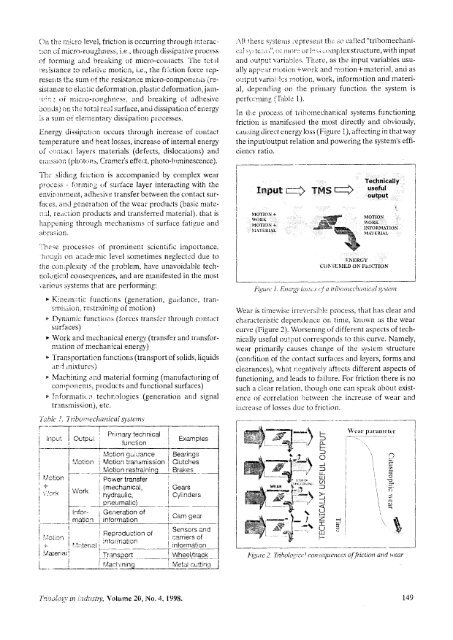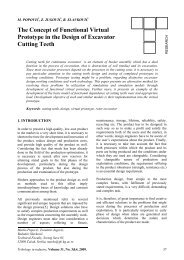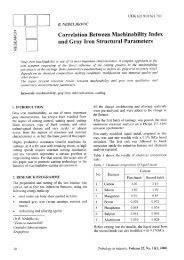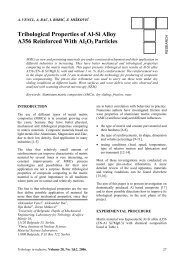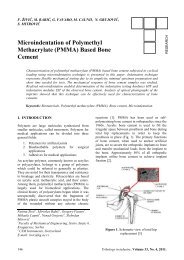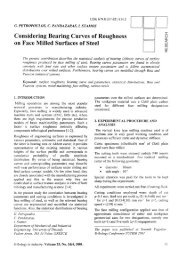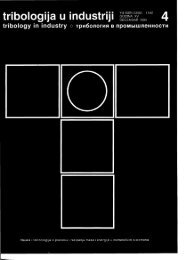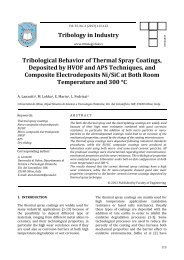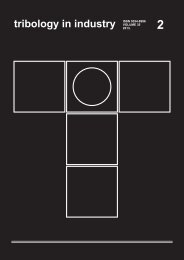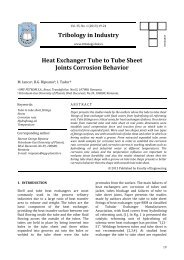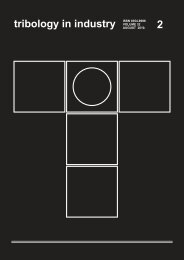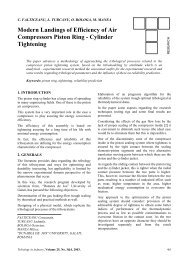No. 4, 1998 - Tribology in Industry
No. 4, 1998 - Tribology in Industry
No. 4, 1998 - Tribology in Industry
Create successful ePaper yourself
Turn your PDF publications into a flip-book with our unique Google optimized e-Paper software.
Cn the raicrc levei, irictron is occurr<strong>in</strong>g through irit;rac"<br />
:lcn of miss.!-roug,Frli:5.s, i.e . through diss.ipative piocess<br />
of iormiiig and break<strong>in</strong>g .--rf micro-c.ilittcts. 'iJre tct'll<br />
;'e:.isiance to relaii'' c motic;n, i.e., the frir;tion force represerrts<br />
thc sum r..f tlic-. resistance micro-cornponeiris iresistance<br />
tc eiasiic deformation, pl;istir Cefornration, jam-<br />
'lilI ,-rf mici'o-ror-r{ht:ess. and break<strong>in</strong>g of adltesive<br />
uciriisj on ihr,'tctei rer.l :-iurface, anri riissipatiofi cf euirrgy<br />
:,q a surn c-i ;lementar;,' dissipation Frccesses.<br />
iJnergi cissipiltion ocLrurs through <strong>in</strong>crease of corriact<br />
tenperature and hea,t losses, <strong>in</strong>crease of <strong>in</strong>temal energy<br />
Lif r.'liii.aci layers materials (defccts, dislocaiions) and<br />
ei il3,:iio i'l (phr.' t,-, n s, Crame r's eff eil, pho to- h r m<strong>in</strong> escence).<br />
Thr slidirg friction is aocompanied by co<strong>in</strong>plex wear<br />
pro(:s:i-s - fcr<strong>in</strong>iri; r.,f s::r'iace layer <strong>in</strong>teract<strong>in</strong>g with the<br />
envir,rrirnent, adhesive transfer between the contact surf;rccs,<br />
an.i generatio;i of the rvear prcducts (basic materi:1,<br />
reirliion products and transferred mitterial). that is<br />
happenil:g thror.rgh nrecharrisnrs af surface fatigue and<br />
aBiiistOI-r.<br />
'l'he-e processe-r:f prorn<strong>in</strong>ent scientific importance.<br />
.hougir rru academic level sometimes neglectrii due to<br />
the ccr:,ple, Infcrmaticu technclogies (generation and signal<br />
trrnsm.ission). etc.<br />
i ':hlt' i. 7 r!bu':itcitrztricoi sl,r/crtts<br />
Outptr!<br />
i iiloticn<br />
rt-ii:-n l---'-- -<br />
Primlry tecnnical --<br />
:1_;^- 1 Examples<br />
runcilon I<br />
If^]i^- -, :.:^^^--<br />
rvlJllL,l | 3ui;el<br />
llg<br />
Motion transmission<br />
fuloticn restra<strong>in</strong>!nc<br />
Bear<strong>in</strong>gs<br />
Clutches<br />
Brakes<br />
.'\I!:liei.e s','ste'iis i-epre-se1it th{ lii-r caIied "tribomechani-<br />
;;! iti';19,,r""" iii i1l(it':j oi i::;.;..r lit-tpieX Structufe, with <strong>in</strong>put<br />
arid dutpui uotiol;ir-::t. Tircre , as the <strong>in</strong>put variables usually<br />
apir;ir ni,-iiir'ti*woik and r:otion*rn:rterial, anci as<br />
r)iltput variiii,lcs <strong>in</strong>ot,irJlr, work, <strong>in</strong>formation and rnateri'<br />
al, depead<strong>in</strong>g on the prirnarl functior, the system is<br />
perfti::nr<strong>in</strong>g i libie 1 ).<br />
In the procesr of tr'iirolnechanicai systems function<strong>in</strong>g<br />
tliction is manifesred the most directly and obviously,<br />
cau:,<strong>in</strong>g direct energy loss (Figure i), aftect<strong>in</strong>g <strong>in</strong> that r.vay<br />
the <strong>in</strong>puVoutput relation and power<strong>in</strong>g the system's efficiency<br />
ratio.<br />
I<br />
l__<br />
Input L TMS t+<br />
I\IOTION +<br />
WORK<br />
nt011cN +<br />
]\i,,\ TI'RIAL<br />
Technically<br />
useful<br />
outout<br />
!.<br />
MOTION :<br />
woRN .,<br />
IN!'ORtl,t-rroN<br />
]\tA'l tiRtaL<br />
liNtrR(;y<br />
CuNlsUIlttrD oN F'lil(--IION<br />
Figurt i. f)rtct-g' 16';, s '.:! a lribr;titclnitical s1'stcnr<br />
.-;\<br />
'**l/<br />
,w<br />
r.Wm* -"1r&tffi<br />
wiib<br />
Wear is t<strong>in</strong>-rervise irreversible process, that l'rzrs clear and<br />
characteristic dep.en.1.na" oii t<strong>in</strong>le, kttou'tt as the wear<br />
curve (Figure 2). Worsen<strong>in</strong>g of different aspects of technically<br />
useful oulirut corresponds to this curve. Namely,<br />
wear primarily causes change of tire sysiem structure<br />
(condition of the contact surfaces and iayers, iorms.anct<br />
clearances), rvhat r;r-'gativeiY aftects different aspects of<br />
function<strong>in</strong>g, and leads to failure. For friction there is no<br />
such a ciear relation. ihough one can speak about existencc<br />
r;i' correlatior.i i:vtrveen ihe <strong>in</strong>crease of wear and<br />
ilicrelse of losses duc tc friction.<br />
.diiditN:<br />
7<br />
-)<br />
F<br />
:f<br />
_l<br />
:)<br />
u<br />
tt I<br />
=<br />
J<br />
_l<br />
Wcat'pilrarrrcter'<br />
i-------<br />
"a.<br />
r)<br />
=<br />
I<br />
iI<br />
I<br />
'tt\,ett I itso.#ertransler<br />
: Senscrs<br />
\<br />
I<br />
U -Z{<br />
I<br />
heDrcouclion o1<br />
. i Caf!-lefs Ot<br />
r<br />
and<br />
;-"" i,,l.,re,.ier t'^t1:11|a__,_l idqlrcqsil<br />
rviaieriaii<br />
ilr+gpgit _,__, I u:te9Jl!rec!_<br />
r i ':---'<br />
I i l i,rlr^l- rr4-' -,-- ii^+',1 ,-r,rt<strong>in</strong>d I I llr lv ,vr


